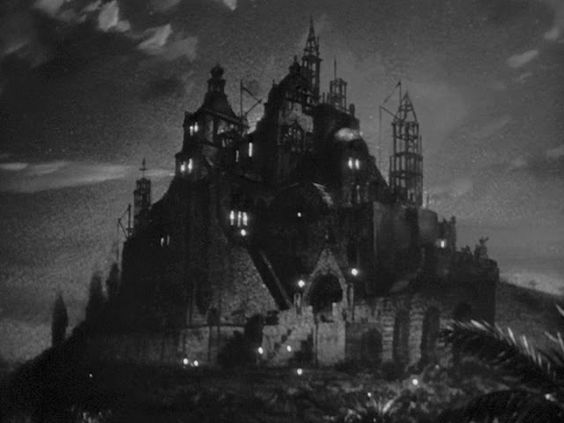I think we can all agree that Charles Foster Kane was bigger than life, that his character and story arc fit his status as a newspaper tycoon and the protagonist in Citizen Kane. However, in the case of Kane, art is not far from reality. The real-life Charles Foster Kane, a man by the name of William Randolph Hearst, had a similar life to that of Kane, but the fascination truly begins when we look at Hearst’s reaction to the film Orson Welles made on his story.
Prior to watching Citizen Kane, I knew that the film had been based on the life of an actual person, though I did not know anything more. After my viewing, I began to wonder how such a story could actually have a place in our reality (I mean–collections of packaged statues, mine-induced fortunes, and even Xanadu?). So, after conducting some research, I came upon a PBS article that not only informs of Hearst’s insane life, but also his suppression of Citizen Kane through his power as a newspaper tycoon. My mind began drawing connections between reality and art instantly.

Hearst (left) and Kane (right)

The article starts off by briefly discussing both Welles and Hearst’s lives and their rise to power. For the sake of the post, I will focus primarily on Hearst despite the existence of connections between Kane’s character and Welles himself. To put it briefly, there exists a multitude of parallels between that of Kane and Hearst. Both started their career from the help of money gained from mines (though Hearst was born wealthy), became newspaper tycoons, published biased/fictionalized stories, and even built private palaces (San Simeon for Hearst; Xanadu for Kane). Everything I’ve said so far may come to as expected rather than surprising, Hearst is said to be an inspiration for a reason. Yet, despite all of the more “obvious” connections between Kane and Hearst present within the film itself, the most striking similarity between the actually occurs after the production of Citizen Kane and takes place not within its screen duration, but in reality!


With all things about Hearst and Kane considered, it would be easy to infer that Hearst’s reaction towards Citizen Kane would be of a negative sort. However, nobody, perhaps not even Welles himself, could have predicted the poetic irony in the way Hearst conveyed his disdain for the film. According to the article, Hearst employed his power as a newspaper tycoon to do as much damage to film’s release as possible. Everything from smear campaigns on Welles’ personal life to actual FBI investigations was used in Hearst’s effort to suppress Citizen Kane. Hearst was largely successful in his endeavor, it would take twenty-five years for the film’s revival and for Welles to gain more widespread recognition in directing one of the greatest films of all time.
Now, about that poetic irony…anybody who has seen Citizen Kane can point it out with their eyes closed. In trying to declare that Kane’s character was nothing like himself, Hearst would ultimately end up reaffirming Welles’ choice to use Hearst as the key inspiration for Kane. Almost identical to Kane’s actions in the film, Hearst uses the newspaper for his own personal gain and goes against the core value that newspapers were founded upon–unbiased truth. Hearst’s choices following his critical reception of Citizen Kane only led to his alignment with its selfish, power-absorbed protagonist, Charles Foster Kane.
Works Cited:
Having known that Citizen Kane was based on a real individual, as well as qualities of the director Welles, I was particularly interested in how the film was received. It’s comedically ironic that through his effort to suppress the film with his newspaper’s influence, Hearst effectively personified the controlling character of Kane himself. I wonder if this was a self aware act by Hearst or even deliberately set up on the part of Welles who must’ve been familiar with how the film would be received. Pulling further on Hearst’s attempted suppression of the film, it’s clear that art can have a resounding effect on its interaction with the real world. Whether Hearst truly didn’t see himself as Kane the newspaper tycoon, or if the film simply hit too close to home is unclear; but the film offers a perspective on the man just as the multiple narratives of the story do all the same.
On the topic of real-life dramatic inspirations and characters, I like to bring up Wolf of Wall Street in relation to Citizen Kane. Now at a glance these two films are different contextually and ultimately fall into separate genres, but serve the exact same director’s intentions. Whereas in Citizen Kane, the story follows a dramatic portrayal of Hearst’s life, Wolf of Wall Street takes the same approach and morale to Jordan Belfort. Although this film is popularly misinterpreted by certain audiences, it too aims to evaluate the cultural plagues of materialism and corporate America. Ironically enough, the same exact themes of familial independence, success through exploitation, relationship neglect, and final reckoning of success with conscience are present in both films, in identical order/pacing. It is truly interesting to compare how audiences view the film representation of figures like Hearst and Belfort throughout time, as the reception towards Belfort was unintentionally sympathetic in contrast to Charles Foster Kane.